The skills required for validating new sites are often a significant bottleneck in 5G rollouts. Despite the promise of autonomous networks, the initial tuning and acceptance of 5G sites still requires time-consuming drive testing. However, a lack of sufficient skilled resources available to do the necessary testing leaves operators, and their system integrator partners, with a problem: how can they streamline the 5G site verification process so they can quickly and cost-effectively roll out newservices? And how can they use automation to both improve the accuracy of their network testing and avoid their highly qualified RF engineers being stuck in cars driving around manually testing?
The challenge: quickly rolling out 5G
Within operators, the responsibility for initial 5G site tuning and verification sits with the network deployment team. However, such is the scale of the challenge of quickly rolling out 5G that many operators also turn to system integrators to assist with the 5G site verification. In this case study we look at a major system integrator that is performing site acceptance services for a significant number of 5G networks globally. They faced the challenge of not only scaling to support operators’ 5G roll-outs all around the world, but doing so against the backdrop of a lack of sufficient skilled resources available to do the necessary testing.
Streamlining site acceptance with automation
They required a solution that would enable them to scale and simplify their site acceptance process by centralizing orchestration and on-device testing guidance. This AI-driven, automated approach would allow their RF experts to centrally define and distribute the required testing routines, while the time and labor-intensive drive testing itself could be carried out by people with no RF expertise.
The customer calculated that automated site verification would reduce the cost of testers by 50% due to automation delivering efficiency and the solution not requiring expert operators.
What is Automated 5G site verification?
Automated site verification involves guided drive testing, orchestrated and managed centrally, to validate that new 5G sites and clusters provide the intended coverage and that all voice and data services are working as expected before subscribers are allowed to access the network. By integrating network planning and testing data into a central cloud-based solution, RF engineers at HQ can centrally define testing routines, identifying what to test, where to test and how to get there. In turn, this guidance and automation of testing means that anyone can conduct the drive testing, with no in-field RF expertise required. The automation and reduced reliance on skilled RF engineers increase the number of sites that can be verified, accelerating the site verification process. Automated site verification removes trial and error and significantly reduces the time to market of 5G.
Now read about 5G site verification in our 4-minute explainer blog article.
Accelerating 5G roll-outs with automated site verification
Legacy testing processes simply aren’t fit-for-purpose when it comes to 5G networks; their complexity, magnified by the environments in which they are being deployed, is making multi-site testing a costly and time-intensive overhead. Automating testing routines to identify where testing needs to be done is a gamechanger for operators – and their system integrator partners – who are racing to deploy new 5G sites. Put simply, you can’t afford for your RF engineers to be driving around the country validating new cell sites; you need them working on core engineering tasks such as RF optimization. Automated site verification makes the network testing process quicker and more accurate, so that the cloud rather than your valuable but finite engineering resource is doing the legwork.
In the case of this major global system integrator, initial tuning and acceptance of sites was an ever-present bottleneck. Their site acceptance services all required time-consuming drive testing. The lack of sufficient skilled resources to do the necessary testing compounded the challenges they faced as they scaled to support more 5G operators.
They needed an automated single site verification (SSV) solution that would guide non-expert guide testers throughout the process and use AI/ML to decide where to test and what to test, reducing overall testing effort.
This would enable them to:
- Scale and simplify the site acceptance process;
- Activate operators’ 5G sites sooner;
- Maximize the value of their finite resources of skilled RF engineers.
The solution: Infovista's TEMS™ network testing solutions
This is why they selected Infovista’s next-generation TEMS network testing solutions. The TEMS™ SSV App provides a simple user interface with on-screen guidance and automated execution of testing routines, enabling people with no RF expertise to conduct the tests in-field, anywhere in the world. Using TEMS™ Cloud, their RF experts can now centrally define and distribute the required testing routines to TEMS SSV App. With this approach, their site verification process is significantly more scalable, helping them get customers’ 5G networks to market faster.

The TEMS SSV App combined with TEMS Cloud centralized network management and analytics enables the team to:
- Manage testing centrally
- Minimize field time with AI/ML
- Guide testers
- Prevent re-tests
- Scale operations
- Analyze results centrally
The 5 steps to carry out automated 5G site verification
In practice, automated 5G site acceptance and tuning can be broken down into five steps, each informing the other and enabling both greater accuracy and speed across the end-to-end process.
Step 1: creation and distribution of assignments
It all starts with the creation of a site verification project. This is done centrally by the RF experts at HQ ensuring consistency across all test routines. Key steps include selecting the sites to verify in the project (either by importing them or manually creating them) and deciding what tests to run (for example, voice/data, stationary/mobile). Once defined, these centrally-managed test scripts and work orders are uploaded to TEMS Cloud together with definitions of ‘start’, ‘done’ and ‘failures’. Finally, the HQ team assigns site verification work orders to a tester, and the drive testing can begin.
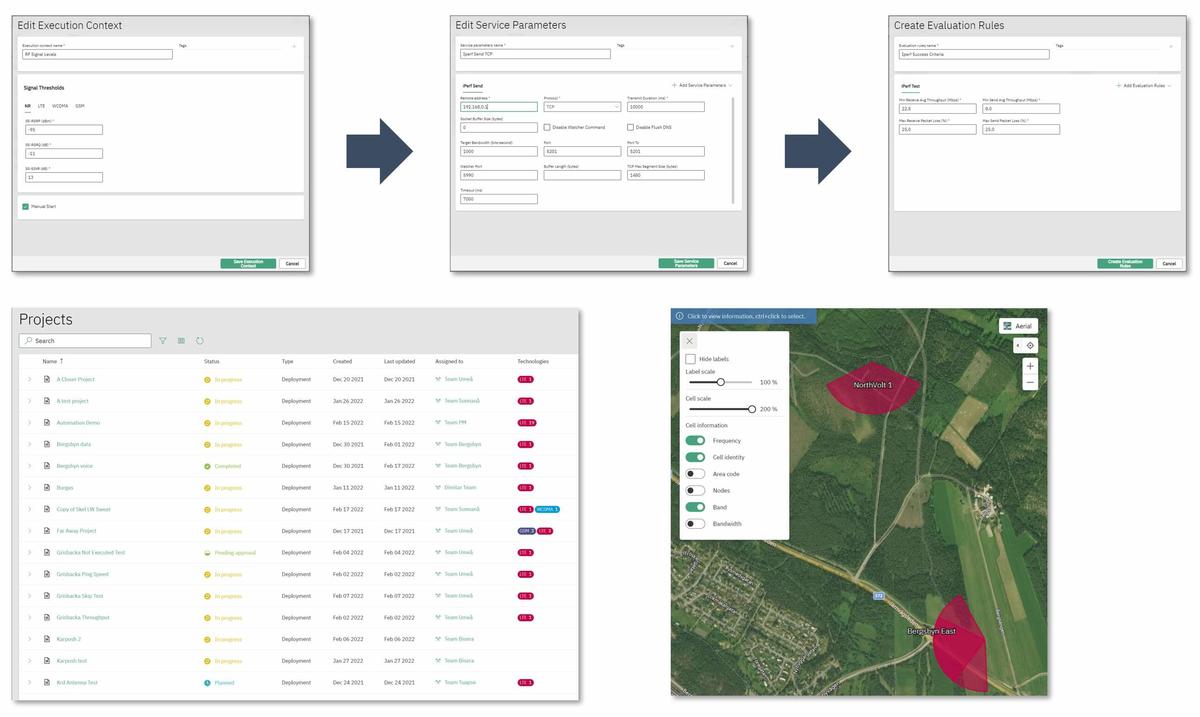
Step 2: acceptance of assignment by tester
In-field, the tester (who remember now requires no specialist RF skills) can simply login to the TEMS SSV App on their own standard smartphone, accept and select an assignment and they are ready to start, with all the network parameters already set and confirmed.
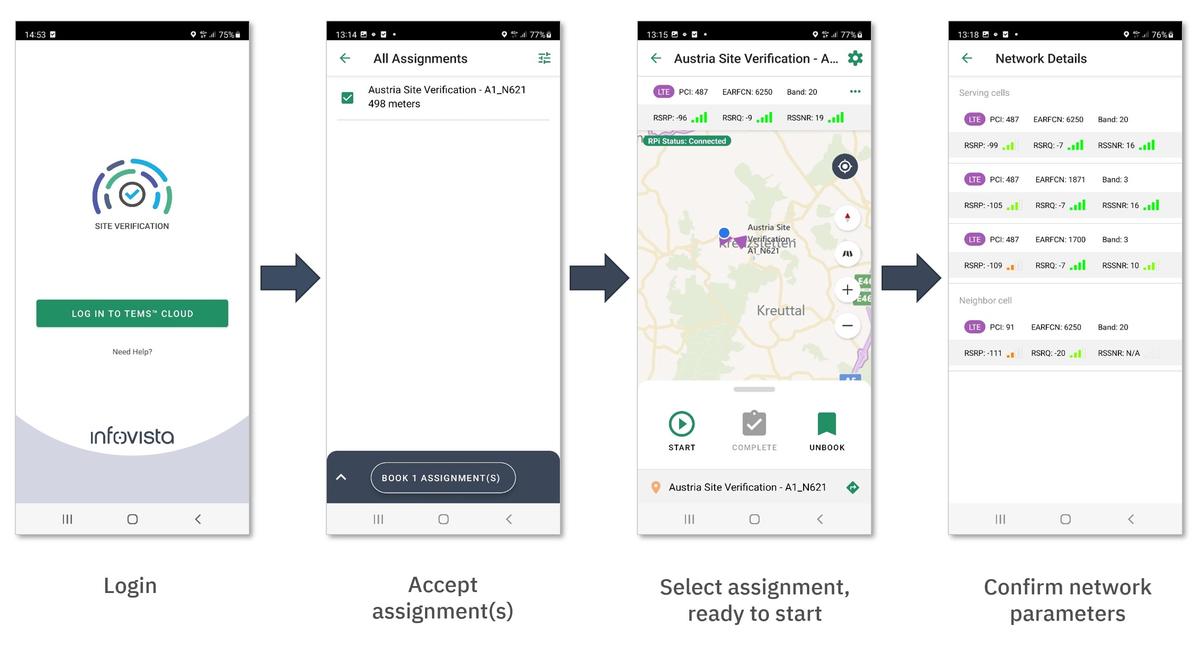
Step 3: guided testing with the TEMS SSV app
The tester is then guided through the whole drive test process, following any instructions provided and allowing tests to execute when in location. Testing progress can be monitored remotely in TEMS Cloud ensuring that any errors are identified while the tester is still on-site, avoiding costly, time-consuming and fuel-guzzling re-drives.
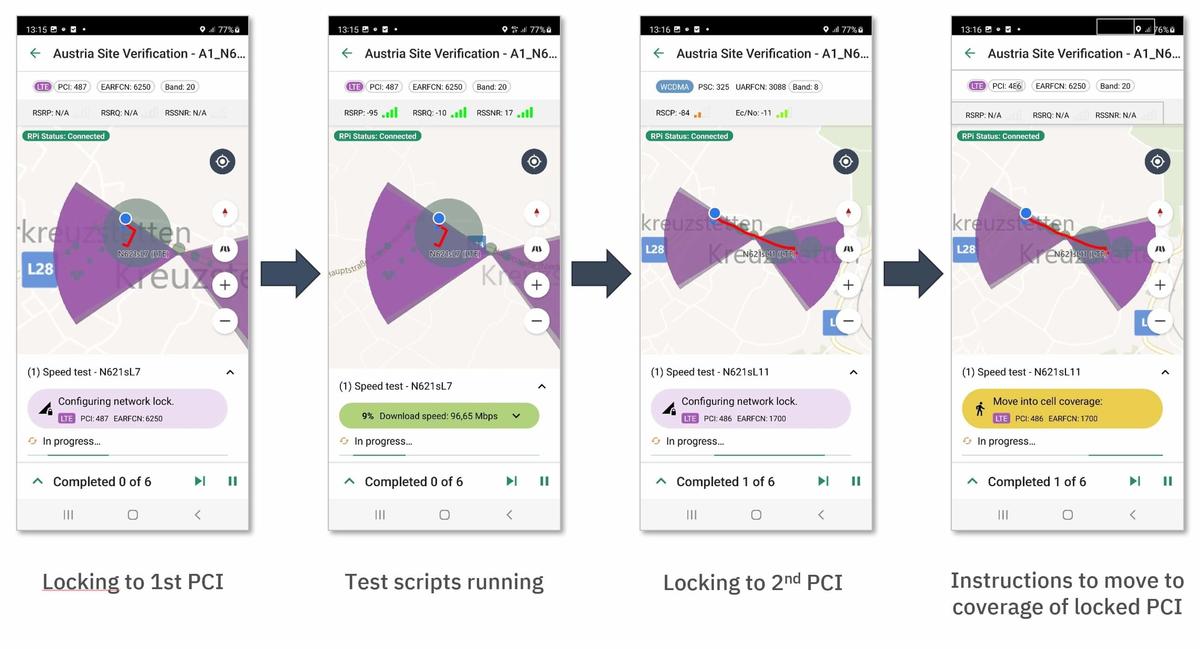
Step 4: confirmation of success and data upload
With the definition of done pre-set centrally, TEMS SSV App informs the testers when all tests are passed. While they can view results in the TEMS SSV App if required, to complete the assignment they just upload the data to TEMS Cloud for the team of RF experts back at HQ to analyze and report.
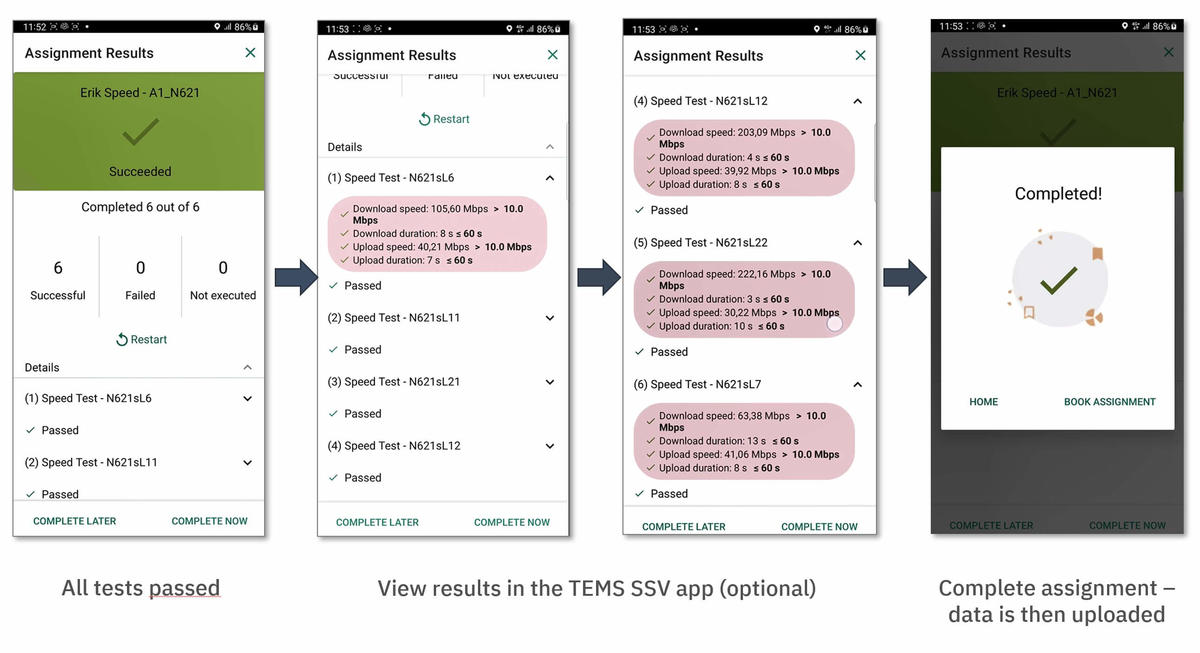
Step 5: centralized monitoring and reporting
Throughout all the steps above the team at HQ have visibility and control over all the testing. They can also select specific projects from the full list in TEMS Cloud and view the test execution status of all assignments within the project, and view site verification reports for each site. This centralized monitoring and reporting enables the team to deliver comprehensive and timely reports to their customers, ensuring they are meeting the KPIs agreed with the operators.
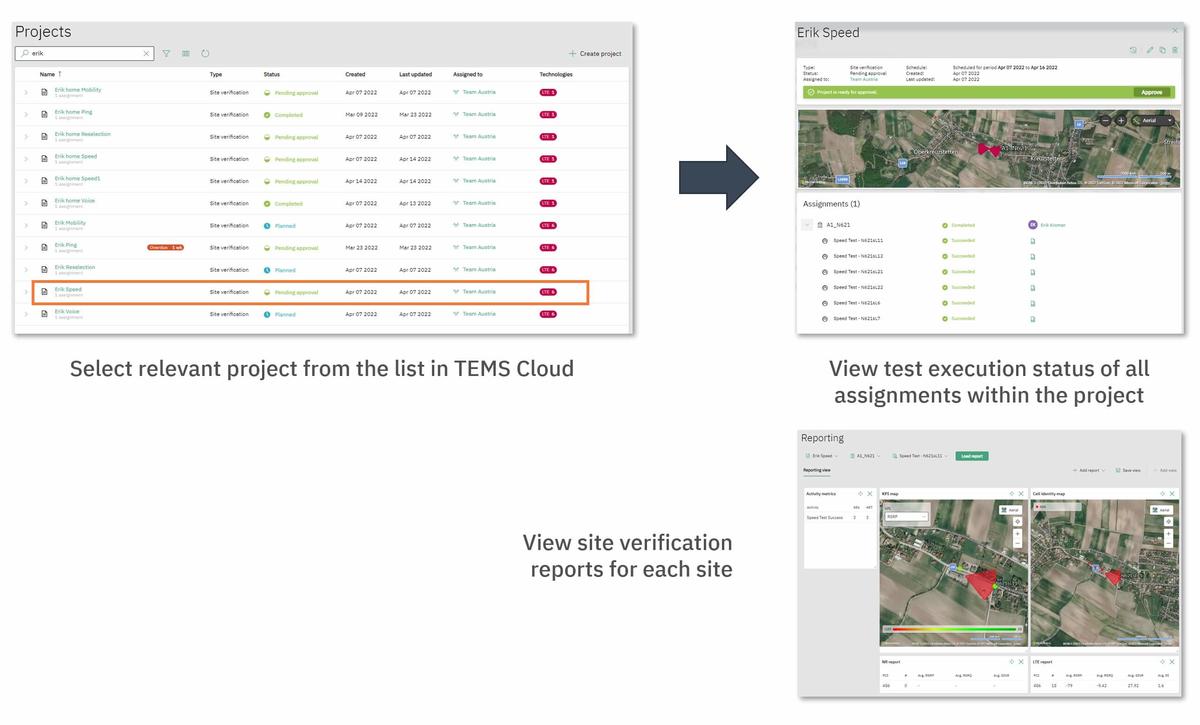
The benefits of automated 5G site verification
When deploying new technology such as 5G, it is critical to confirm that new sites are performing as expected before allowing customers to access them. This is equally true for existing technologies where new sites are added to expand coverage or increase capacity.
TEMS SSV App, coupled with TEMS Cloud, has allowed the customer to efficiently verify the performance of all new sites so they can continue to deliver the quality of service that both operators and their subscribers expect. By automating and streamlining much of the process, they have estimated that they will be able to reduce the cost of testers by 50% by delivering efficiency and enabling them to use non-expert testers in the field.
The benefits of TEMS™ Automated Site Verification include:
- Automated – it leverages Infovista’s Precision Drive Testing™ to identify what to test, where to test and how to get there
- Anyone can test – in-app guidance and automated testing enables anyone to perform testing
- Centrally managed – TEMS Cloud manages the orchestration of projects, users, and test equipment
- Standardized testing – centrally-defined test routines ensure consistent testing free of human error
- Instant reporting – instant reports on-device and in TEMS Cloud ensure the shortest time to result
- Commercial devices – the TEMS SSV App runs on a wide range of standard smartphones reducing setup time and improving project scalability
Taking a step forward to next-gen network testing:
For more on how network testing is combining with orchestration and analytics to automate next-generation network testing processes such as 5G site verification, see our latest use case eBook: Evolving network testing – an eBook of 12 use cases.

More helpful pages:
- Case study: How a major European MNO uses the TEMS™ Suite to deliver its 5G network
- eBook: Evolving network testing – 12 TEMS™ use cases
- Blog: 5G site verification – what is it and why does it matter?
- Blog: 5 benefits of 5G site tuning – and how to realize them










